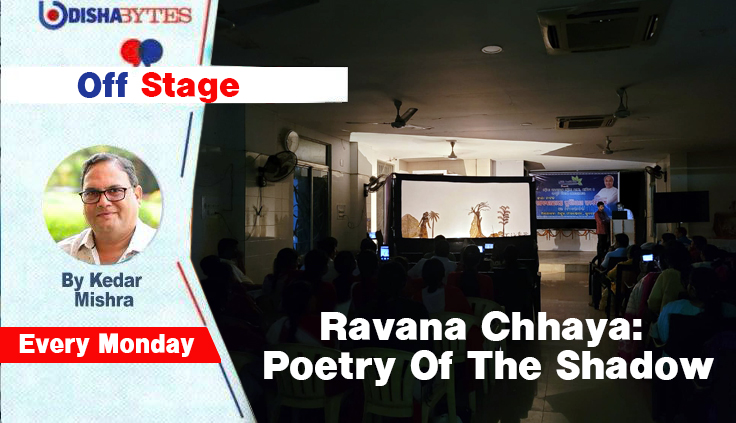Ravana Chhaya: Poetry Of The Shadow

The transformation of a bioscope into a motion picture is quite a recent phenomenon. Historically, the motion picture by Lumiere Brothers was first released in Paris on December 28, 1895. That is the one-liner history of cinema, but in Odisha, we had a desi version of motion pictures, which was as ancient as the first civilisation in Odisha.
Odisha is known as the citadel of puppetry. This is the only state in India where all forms of this genre of performing arts – glove puppet, string puppet, rod puppet and shadow puppet still exist. These forms are known by different names, such as Sakhi Kandhei Nata (glove puppet play), Ravana Chhaya (shadow puppet play), Ramaleela Kandhei Nata (rod puppet play) and Gopaleela Kandhei Nata (life-size puppet play).
Among the puppetry streams, Ravanachhaya is a distinct art form, which was almost rare in practice. The tradition of shadow theatre in Odisha is age-old and known by the name Ravana Chhaya. A lot of evidence on shadow theatre is available in the Mahabharata of Sarala Das of the 15th century A.D. Ramayana of Balaram Das of the 16th century and in the kavyas of Deenakrushna Das, Upendra Bhanja and Abhimanyu Samantasimhar of the 17th and 18th century A.D.
Words like ‘chitrapata’ (photo), ‘pattachitra’ (applique) and bimba (shadow) have been used in these mythologies as synonymous with shadow play. Living evidence of Ravana Chhaya is found in the form of a rock painting in Sitabijh in the district of Keonjhar. This is believed to have been painted sometime between the 2nd and 4th century A.D. This painting is popularly known as Ravana Chhaya among the local people. It depicts the picture of a royal procession. Further, some researchers believe that “Chhauni or Chhatra” (tent or royal canopy) are the two words that have been changed into “Chaya Rupa” (shadow picture) in later years. Surprisingly, there is no use of “Ravana Chhaya” anywhere in those literary works.
Of course, there have been many arguments in support of the name Ravana Chhaya as a form of shadow theatre. The first and most sound opinion could be that the hero of this play is Ravana himself. Secondly, as Rama is conceived as Purusottama and ‘a bodyless entity’ he is shadowless. Therefore, it would be most improper to use the term Ravana Chhaya for a shadowless entity, even symbolically. The third argument is still a profound one. The artistes are of the opinion that Devi Sita was requested by her Sakhi to draw a picture of Ravana, the mighty demon. Naïve Sita drew the picture and Sakhi wanted to know how could she see Ravana. Sita confessed while she was abducted in a Pushpaka Viman (Chariot) by Ravana over the sky she saw the reflection of Ravana in the seawater, The sight of Ravana’s shadow in the sea brought her a tragic future and her chastity has been questioned by the subjects and this ultimately proved the victory of truth over falsehood and deceit; good over evil, the name Ravana Chhaya is most proper here.
The thematic aspect of Ravana Chhaya is based on stories related to Lord Rama. In the first half of the 18th century, Bichitra Ramayana of Biswanath Khuntia provided many stories of Rama for the plays of Ravana Chhaya. Therefore, in all probability and fairness, we may associate the renaissance of Ravan Chhaya with the composition of Khuntia’s Bichitra Ramayana in 18th century A.D.
The puppets used in Ravan Chhaya are made of the un-tanned hide of deer, sambar and mountain goats. These puppets are only flat plates without joints. They are manipulated by the puppeteers with the help of a prop attached to the lower part of the puppets. Usually, a band of an orchestra (singers and musicians) sit either in front or behind the stage with their musical instruments–Khanjani (tambourine), Daskathi (two flat pieces of the wooden board), Mridangam and small cymbals (a pair of rounded brass plates). While the puppeteers manipulate their puppets behind, the shadows are being projected on screen rhythmically to the tune of music and song.
The stage used in Ravana Chhaya is almost similar to any other stage made for shadow plays throughout the world. The stage is cube-shaped with eight/ten feet on each side. Strong wooden poles or iron pipes of one-inch diameter are used as the supporting bars to hold the covering of thick blue or black cloth on three sides and the bottom part of the front side facing the audience. This part is covered by a piece of coloured cloth. The upper part (almost half of the total size) in front above the thick coloured cloth, measuring approximately eight feet long and four feet height (width) is covered by a white cloth, which is the screen on which the shadows of the puppets fall. The bottom part of the front side is covered by a thick mat of the size of eight feet long and three feet wide. The puppets which are less used are kept fixed on this mat-mesh and whenever the puppeteer feels the need of any puppet, he takes it out at any moment from among these puppets. This mattress serves as a stand leaning on which the puppet artistes take rest. In the middle of the stage, a light source is kept in such a way that the audience does not see its flame. As the audience sit in total darkness they can only see the screen and the action of the characters (shadows) in front of them and nothing more than that.
This form of shadow theatre, Ravana Chhaya exists today as an art form in the village of Odasa and Kutarimunda of Angul district in Odisha.

Comments are closed.